Subjective game reviews, comic translations, pixel art, and other video game bits & bobs.
Don't wanna be here? Send us removal request.
Text
[Review] Notenogram (GBA)

A lovely little homebrew nonogram game!
While talking about GBA homebrew games with my spouse we stumbled upon GBA Jam, an annual game jam on Itch.io where participants make their own new Game Boy Advance games. It gets a fair number of entries too, including this gem from the 2022 jam. Made by kva64, it's a rare entry in the particular puzzle genre of nonograms on the system: Picross wiki only has one official GBA release, by Hudson!
Notenogram takes its name from its notepaper-inspired aesthetic. The whole experience occurs over a grid paper background, every graphic from clue numbers and filled-in squares to the cute anime-style characters appearing as if drawn in pencil in a student's notebook. It's a fun idea, although it isn't the best for legibility, especially the number font.

The puzzle-solving gameplay is quite barebones, as expected for a game jam project. You can fill or cross squares, and undo these marks, while marking crosses doesn't overwrite fills (thumbs up). That's about it. There's no screen wrap, clue marking, hints, or checking, although the ever-present star character Omi will react with dismay if you fill in an incorrect square. The grids are all 12x12 which is unusual, and doesn't include thicker line markings on each fifth border, but I applaud the choice for fitting grids to the screen and graphics without sacrificing screen space or visibility.
The main mode includes 20 puzzles split into four categories: objects, nature, symbols, and portraits. The solutions are mostly recognisable but you'll have to squint at times as there's no shrunken cut-in, and you must commit them to memory as there's no record of you solving them. I will cut it some slack in these presentational aspects due to the short development time frame (3 months)… having said that, a few puzzles require extrapolation or outright guesswork to solve. To be fair, the tutorial does lay this out as part of the format but I always thought of it as poor puzzle design personally. It did feel a little freeing to accept guesswork as a valid strategy though, kind of a rebellious cutting loose from my preferred rigid logical solving, and Omi's reactions are helpful in these scenarios. Plus there's no penalty for mistakes, or a time limit, which is nice.

Well, there is one mode that grades you. Another option on the title screen is for Story Mode, which plays out as a short visual novel section that feels more like a proof of concept than a fully fleshed out experience. Omi is an anime girl who loves arcade games, and decides to try out a nonogram game at her local game centre (the script and tutorial often use the copyrighted term Picross as it's become generic colloquially). There's just one puzzle to solve here—bringing the total in the game to 21—and how well you do changes which character approaches you afterwards: a dweeby kid who struggles with puzzles, a fiercely competitive rival, or the middle option and my favourite, a girl who volunteers at a game preservation museum who is hoping to save the arcade machine from being doomed to obscurity. All three are friendly, wholesome encounters and this little mini-story is a cute addition to what can be a dry puzzle genre.
Aside from the tutorial which explains the concept well, a "Create" mode rounds out the package. It's very impressive to include something like this in a game jam project, allowing you to save up to 5 puzzles of your own design. Overall I'm very impressed with this small-scale homebrew; the aesthetic choices are strong, with the sketchiness and cute characters adding a fun layer, even if the pencil on graph paper look isn't the best for visibility. I was also just pleased to discover people keen to develop for GBA and that there are tools available to do so; GBStudio gets a lot of attention but it's nice to see other retro formats getting love too!
0 notes
Text
[Review] Tokyo Crash Mobs (3DS)

Delusion Now.
When researching Zuma, I found that its formula is lifted from Mitchell Corporation's game Puzz Loop. This is how I discovered that Mitchell themselves revived their arcade classic for Nintendo… in 2006, for the DS, as Actionloop/Magnetica/Instant Puzz Loop in PAL/North America/Japan respectively… and then again in 2008 on Wiiware as Actionloop Twist/Magnetica Twist/Everybody's Puzz Loop. Anyway here they are again, in 2012 on the 3DS reviving the idea but giving it quite a different spin.
Despite the zany appearance, this is clearly an instalment in the series; the title screen has a 1998 copyright date, the Japanese title includes the telltale "Loop" name (Gyouretsu Nage Loop, which means something like Queue-Throw Loop… it sounds better in Japanese), and the gameplay is unmistakable. You throw coloured objects into a moving line of other objects, matching them to make them disappear. This simple description doesn't do justice to Tokyo Crash Mobs though. It's a 3DS tech demo, an FMV throwback, and a silly fever dream rolled into one.
You play alternately as Grace and Savannah, university students in Japan. Grace really wants to get into trendy shops that are having exclusive sales, and Savannah is trapped in a surreal existential crisis/time loop, suffering debilitating hallucinations and what appears to be a kind of spiral mania out of Junji Ito's Uzumaki, while repeatedly being ejected into the cosmos by uncaring passersby and stalked by a ninja doppelgänger. So, you know, they've both got problems.

This "story" is told through silent, disconnected live-action vignettes which show the women wandering around, encountering crowds of identical people and ninjas. There's a kind of resolution but with many loose ends… but the plot is not the point, the vibe is the point. And that vibe feels like a fun callback to the early days of disc media when digitised sprites and crunchy green-screen footage was all the rage.
When the gameplay starts up, you're Grace trying to eliminate "scenesters" in front of her in the queue for a shop opening. These primary-colour-attired townsfolk are obnoxious, and as you progress more will push in, shield themselves with flowerpots, etc. You start holding people above your head, tossing them into the queue to clear away matches and get closer to the front yourself. It starts sedate but the time pressure and new obstructional gimmicks ramp up quickly over the course of 21 stages over three "weeks".
Every other day you're Savannah in a more abstract space, with more familiar Zuma-style gameplay where you have to stop a conga line from reaching a button that will plunge her into outer space, or something. The folk in these stages can hop out of your way, or do a dreaded forced march which is very hard to stop. Savannah bowls humans along the ground rather than throwing them, which makes for a different dynamic with the expanding queue. Each of our heroines does get the occasional powerup to turn the tide, but only one per stage and only if you're able to grab it.

These stages are entirely stylus-controlled, the bottom screen showing a simplified view of the offending line, only without colour. This can help a bit but the frantic pace means you'll rarely be able to spare a glance down. The top screen shows a tilted perspective that can make it frustrating to line up tricky shots because of the overlap, a downside of the goofy sprites converted from photos that cycle through different poses. The stereoscopic 3D is supposed to aid with perspective but as is often the case [for me], it's more of a visual distraction or strain.
Sunday's stages are special team-up battles against an army of ninjas. These have you behind the back of the now united students, facing an expanding row of deadly/silly assassins, using both throwing and rolling to fend off their attacks. By default you aim by moving the 3DS in real space and pressing buttons, but it's possible to switch to stylus controls/touch targets which are less physically demanding but not as responsive. These don't work quite as well as the core stages but are a fun change of pace (and I think optional?).

With the campaign finished and the story dubiously concluded, you have a few options. A new game plus lets you do the stages again but much harder and with all the gimmicks from the start, a challenge mode has you tackle each stage type in long-running gauntlet formats, and a "movie maze" is just an excuse to show you more of the FMV footage with a very light selection mechanic.
It's a nice little package that doesn't overstay its welcome. I'm disappointed that I didn't check it out ten years ago when it was in the Club Nintendo digital rewards program (remember those??). That is to say, I definitely did that and just haven't got around to playing it until now, it's not like you can just get digital 3DS exclusives for free these days with a few simple steps. Regardless, I have a lot of appreciation for it now that I now it's even more part of the Puzz Loop legacy than Zuma is, and the chopped-up live-action movies and sprites give it such an air of fun wackiness. As the loading screen says, "Delusion Now"!(??)
11 notes
·
View notes
Text
[Review] Zuma's Revenge (PC)

A beautiful little time-waster.
For a bit of nostalgia I picked up a Popcap bundle on Steam. Their games were some of the first I had when I got my very own laptop for the first time. I used to spend hours on Zuma Deluxe when I was supposed to be studying for uni. No regrets. Well, some regrets.
For this trip down memory lane I first booted up the older Zuma Deluxe from 2003. It still has the power to suck my time away, and before I knew it Steam was telling me six hours had gone by! However, the difficulty curve was too steep and the Steam Deck touchpad, while surprisingly responsive, was not effective enough a replacement for a real mouse. How I ever did this on just an iBook's trackpad is beyond me! So I got stuck on world 9 and decided to move on to the sequel.
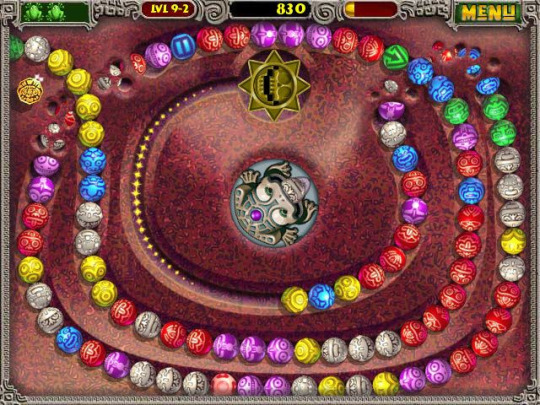
The Zuma formula is a good one, a match-3 game but with a dimension of action and skill (on top of the usual randomness). Your frog character fires orbs out of their mouth which join a snaking line of orbs, trying to match and combo to stop the line advancing to the dead end. Puzzle Bobble but more dynamic. The stage design gives a good amount of variety to each new level, and powerups help to stave off the relentless orb crusade (although they too often seem to blink out just when you're about to nab them). Of course, like most Popcap games this is a ripoff of an earlier format, in this case Mitchell Corporation's 1998 arcade classic Puzz Loop/Ballistic. Popcap got there first in cloning it but were followed before too long by Luxor and Sparkle.
Whatever iteration it's a fun design. Zuma's contribution was adding a potentially slightly racist layer of Central American theming, and of course the timeless frog character. Zuma's Revenge followed in 2009 with the frog washing up on a tropical island, the setting being swapped out for a slightly racist "tiki" theme that Americans seem to love so much. At least you don't have a guide character speaking to you in broken English this time. Instead there are boss tikis who taunt you as you get closer to their lairs.
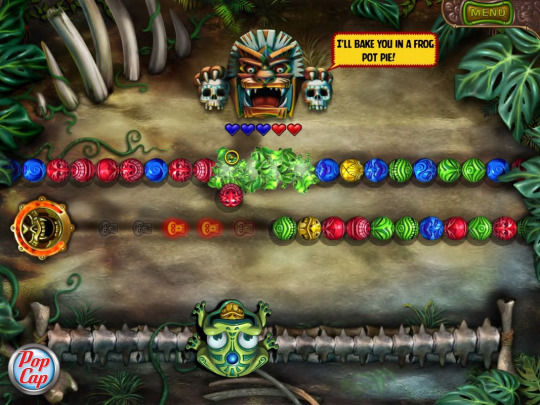
The boss fights are a highlight, with little gimmicks to shake up the gameplay. The final boss in particular has a fun fakeout and gives you infinite retries; much appreciated. There's other additions since the original too: more cool powerups, some levels having you swap between positions or slide on a rail rather than rotate, and new gameplay modes (they're mainly just more difficult versions of the main game, so I didn't delve too deeply). There's also the expected layer of polish over the whole experience. Plus I didn't get hard stuck for hours, so the difficulty must have been rebalanced a bit for the initial campaign, which is nice.
Popcap are [or were] great at making addictive gameplay loops, getting you into a flow state, as well as infusing their games with colour and character. It's no wonder they became an indie success before being scooped up by EA. Sadly, past this point their output became gradually more scummy and focused on free-to-play (but heavily monetised) Plants vs Zombies spinoffs. Zuma has had a time-limited Facebook iteration—now delisted— in 2010 but post-EA the series has seen just… a literal slot machine. Ugh. Maybe one day we'll get the Peggle or Zuma sequel we deserve, but it's seeming less likely the more layoffs happen over the years under their corporate overlords. Now I've made myself sad. At least we'll always have Zuma's Revenge for $1.50 on Steam.
4 notes
·
View notes
Text
[Review] Bomberman '94 (PC Engine)

It's Bomberman... but he's in 1994! [Released in 1993.]
My retro game club is covering this game this month, and for once I managed to play through the pick… it helps that it's short. Just another instalment in Hudson's long-running Bomberman series, '94 didn't leave Japan in its PC Engine configuration, although the Mega Drive conversion did. There were graphical sacrifices though, so the original release is the best way to play and the only language barrier is some menus and world names.
The story mode introduces Bagura who becomes a recurring nemesis for Shirobon and pals, but here he's just some guy from space. Planet Bomber gets split into five chunks which act as the worlds you must battle through in order to restore things to normal and (presumably) rescue the other coloured bombers who are shown on the map screen.

Now I'm no Bomberman expert so I can't really say what's new or what's getting old at this stage of the series. The levels are complex mazes with world-dependent gimmicks, colourful tilesets, and crawling with enemies. I wasn't a big fan of the stages covering more than a screen, requiring scrolling around to see what's going on, but it does let them make more interesting layouts. The enemies all have particular behaviours and abilities, some of which are obnoxious to deal with like passing through soft blocks or taking multiple hits to defeat.
The difficulty level is quite high especially later in the campaign, and I would have got really ticked off if I hadn't used rewinds as much as I did. A single hit, whether from enemies or your own carelessly placed bombs, is enough to reset your special powerups (kick, walk-through bombs, the particularly game-changing remote detonation, etc.) but you do keep your bomb count and explosion size until a game over, and as far as I could tell continues were unlimited and didn't set you back too far. The bosses are a huge difficulty spike as well, albeit impressively large and with fun designs.

I do know that the big new addition for this game is Louie. Clearly cribbing from Super Mario World, Louie is a large kangaroo that your Bomber can ride, whose colour gives them different abilities. Also they hatch from an egg, obvious much? Green is the default and can dash, purple can jump over obstacles, etc. The best is the pink one whose ability is to do an adorable little dance. That's it. It's totally worth it! They do also have the benefit of taking a hit for you, letting you survive longer with your own hard-won powers intact. Since they are randomly found like all powerups, you can go a long time without seeing them; in my whole [tool-assisted] playthrough I only ever got four Louies and three of them were yellow! If you manage to keep one through the gruelling three-phase final boss you get an extra little heartbreaking scene at the end too. They're a good addition to the series and provide a fun little buddy dynamic along with their gameplay usefulness, so I'm all for them.
Of course a big part of the series is the multiplayer arena battles… I didn't touch that part of the game. Sorry! Bomberman already isn't my favourite thing and the PVP even less so. I'm glad I got to see an important step in the franchise with this one but it's a very punishing experience that often had me feeling powerless and not in control, as the enemies blundered around into me and I got caught in my own blasts. More practice would help hone my skills, but for now I'm just happy I got to ride Louie a few times and spend a little time in Hudson's colourful and cartoony world, it wasn't a million miles away from my beloved BC Kid which they're also involved with.
3 notes
·
View notes
Text
[Review] Super Monkey Ball: Sakura Edition (iOS)

Soon to be lost media.
In 2017, Sega began Sega Forever, an initiative to release their retro games on modern mobile platforms. This included lots of Mega Drive games, Crazy Taxi, and even games made earlier for mobile that had been delisted like Sonic 4 Episode 2, or Super Monkey Ball 2: Sakura Edition (more on the name in a minute). The project quickly ran out of steam and now it seems that Forever was itself a total misnomer, as these games (and other Sega mobile titles) are being delisted themselves.
The silver lining to this blow against preservation is that Sega is pulling a Good Guy move and making all these games free before removing them (and apparently stripping the ads from the ad-supported ones). This is how I came to play this semi-unique Monkey Ball title.
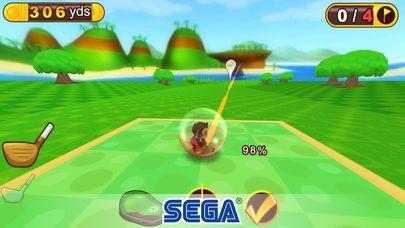
This is actually the third Monkey Ball release on iOS. In 2008 Other Ocean, a Canadian studio newly independent from Backbone/Foundation 9, made for Sega the unimaginatively titled Super Monkey Ball, a tilt-controlled take with content based on the Wii launch title Banana Blitz, although as far as I can tell the levels are newly designed. The follow-up SMB2 was more of the same taking from the five worlds not already adapted in the previous iOS title. SMB2 Sakura Edition followed shortly after, a refined rerelease with an extra world based on the newer Wii title Step & Roll—Far East—with a traditional Japanese theme complete with copious sakura.
Now hopefully the name makes sense. Since this game was originally released in 2010, it looks dated with low-poly geometry and character models. I actually like the charm of this kind of graphics though, the simplistic menus and such, and the flat vibrancy is a timeless look.
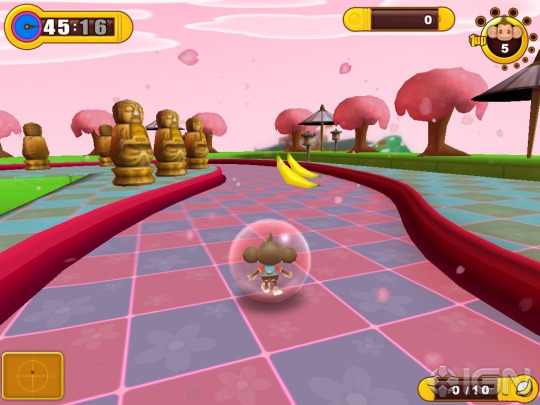
Being completely tilt-controlled in gameplay is a bit rough depending on the mass of your device. My old light iPad worked ok, except that tilting can uncomfortably shift your viewing angle, reflections, etc. I even triggered a 180 degree rotation at one point when I was trying to zoom!
The level designs are a bit gentler than typical Monkey Ball courses from what I can tell, to accomodate this less precise control scheme. It wasn’t until late in the bonus Sakura world that I really started getting grief from the game, and I never had a game over situation thankfully.

The world themes are visually nice, and each has two sets of ten levels plus a single Sakura set, for a total of 110. But there’s no story, no framing, no point; my favourite Super Monkey Ball Adventure’s ambition not to be repeated here at least. The character roster is merely the core four, not even a YanYan to be seen despite being established in the game this one is drawing from. There are some Monkey Party minigames at least, with Target, Bowling, and Golf offering a momentary diversion. But hey, for free it’s a pretty good deal as long as you get it before it’s gone!!
13 notes
·
View notes
Text
[Review] Assault Android Cactus+ (NS)

Totally frantic pew-pew action.
After playing Spartan Assault I wanted more twin-stick shootery goodness, so here's Assault Android Cactus, by Brisbane-based Witch Beam (creators of the excellent Unpacking which I played recently). The Switch port's "+" moniker denotes that extra features were added: a New Game +, optional aim assist, costumes, and other tweaks; these are nice bonuses on top of a solid arcadey action romp.
Cactus is a loose cannon space cop, sent to check out a cargo ship that has gone silent. Turns out its AI brain has become disregulated and rebelled, and the robots that crew the ship have followed suit. On her side are a motley assortment of androids like her on board [technically gynoids but close enough], whose independent brains allowed them to remain sane. The cheesy characterisations, cartoony proportions, and colourful blockiness of the environments belie depths to the lore that are hinted throughout and explored a bit deeper in unlockable encyclopaedia entries, it's a fun contrast.

The nine assault androids are your playable characters, four to start with and more unlocked as you progress the campaign. The game supports up to four players simultaneously, although it's still fun solo (an unlockable option also lets you add CPU players, but each one ups the difficulty). Each character plays very differently, with lots of ideas explored in their various primary weapons as well as their cooldown-governed secondaries whose activation also acts as a dodge button. This simple loop works well, whether your secondary is a strategic alternative or a panic button.
The gameplay is tuned well to be frantic but fair. There's always so much going on on screen that going down is inevitable, but your run isn't over until your battery runs out, and a takedown is quickly recovered from with just a reduction of your weapon XP and score. This keeps the action flowing and makes these self-contained levels manageable, with the challenge of getting a better score requiring better mastery of movement, secondary weapons, powerups, responding to enemy types, and so on.

Of course the boss fights are the most challenging part, marathon struggles with many phases that were my main source of restarts. It was satisfying to learn their patterns though, I just never got a good ranking on them. Oh well. The final boss in particular required me to cycle through almost every character trying to find the one whose abilities best suited the fight. It was great!
On beating the game there's extra modes and modifiers to play around with to extend the playtime, and art galleries and such to view. It's a lovely little package. I wish there was more variety in the voice acting; as far as I could tell nearly all of the characters have American accents except for one Scot, and with an Aussie dev I was hoping for some true blue yobbos but alas. Either way the overwhelming short-burst pure arcade action is the strength here, and Assault Android Cactus does it excellently.
0 notes
Text
[Review] Halo: Spartan Assault (PC)

A cromulent Halo twin-stick shooter.
Off the back of their Xbox 360 twin-stick shooter Gatling Gears, Dutch studio Vanguard Games (who have gone through half a dozen name changes in their twenty-year history) were contracted by Microsoft to make a new twin-sticker set in the Halo universe. Although apparently their first prototypes were converting the traditional FPS gameplay to mobile devices, so there goes that narrative. Either way, Spartan Assault ended up not only on Windows 8 touch devices but console and PC as well, even getting a port to iOS.
Now I already played the sequel to this (Spartan Strike) long ago on my iPad, where I had a decent time despite disappointment with the vaguely-defined player character and the post-Halo 4 setting. I'm sorry but if I hear the words Promethean, Didact, UNSC Infinity, Spartan-IV, etc. I kind of tune out; basically I'm ambivalent about the direction of the franchise post-Bungie.

Assault's plot *is* about some Spartan-IVs with a framing story on the Infinity, but it keeps things simple and self-contained. Your foes are simply a Covenant remnant trying to recover Forerunner weapons on an alien planet/moon system. The weapon set takes a few things from 3 and Reach but on the whole was very familiar to me, and having just come off Halo Wars I was pleased that they incorporated a few vehicles that are otherwise exclusive to that game and its sequel.
The premise is that you're playing a training simulation that recreates the Spartan heroics of Sarah Palmer (who shows up in many of those post-Bungie games) and some other jobber who dies halfway through the campaign. This virtual reality premise explains away any inconsistencies like not having to reload, freeing it up to be a better twin-stick shooter. The bite-size missions then represent key moments in the adventure, filled in with narration and motion-comic cutscenes in between. Can the plucky human spirit and the Spartans' abilities overcome the power-hungry alien threat? What do you think??

At this point the PC version I played (on Steam Deck, with two sticks as intended) contains an extra episode added in an update, an epilogue event that feels like a step up in difficulty. Not included is an online co-op exclusive episode which was only added to the 360/Xbone versions, where you battle the Flood through a Forerunner installation; this faction is totally absent from the base game and its sequel, so it's too bad this content is locked in this way. Oh well.
The shooty bang-bang gameplay feels good, Halo's unique weapons and mechanics integrated well into this new format. The levels are short and sweet, so it's ok that there aren't mid-level checkpoints; the idea is to retry them for a better score, perhaps with modifiers like difficulty-enhancing skulls or bonus weapons. There's turrets and vehicles to break things up, and canny use of grenades and limited ammo resources are important. As with Halo Wars, it's a polished and cromulent conversion of Halo to a new genre. That's all I need to say.
1 note
·
View note
Text
[Review] Halo Wars (PC)

An RTS you play with a controller??
Ensemble Studios had created the massively successful Age of Empires series of historical real-time strategy games. Even back in 2001, Microsoft was greedy for acquisitions and absorbed the company. Within eight years they would be decommissioned and disbanded (sad but all too common), immediately after Microsoft encouraged them to reskin an upcoming sci-fi RTS created specifically for consoles into a Halo game so it would sell better. Bungie wasn't happy about their IP being tossed around like this but who cares, get used to it mate. Halo Wars ended up quite good in the end, getting a later port to Xbone and PC by Behaviour Interactive, and even spawning a sequel (which unlike the first one isn't on Steam and I'd rather not set foot into the MS ecosystem more than I have to).
As the first-ever Halo spinoff, Halo Wars plays it safe by setting itself as a prequel, 20 years before the events of Combat Evolved. Prequelitis sets in pretty quick as they bring in the Prophet of Regret, and introduce a different Arbiter even though it felt like an ancient ceremonial station in Halo 2; halfway into the campaign you also arrive on a world infested by the parasitic Flood, undercutting their impact in the trilogy proper. I get including iconic elements like these, and the game would be lesser without them, plus they paper over the lore by stranding the characters and their ship without FTL travel at the end… it's just funny when a prequel has to bend over backwards to not trip over continuity.
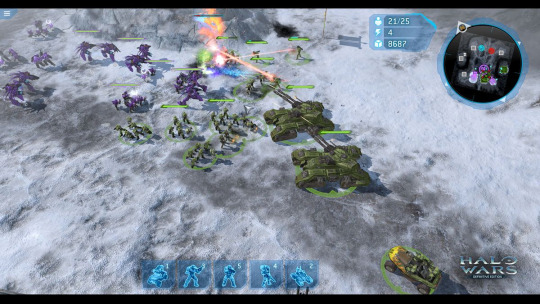
Anyway, the main characters are the crew of a particular ship sent back to the site of first contact with the alien Covenant. You've got the gruff but competent captain, the sassy AI, the tediously standoffish sergeant, and the quirky scientist. They're all thinly drawn but lovingly rendered in the CG cutscenes by Blur Studios, who have worked on the Sonic movies and various other games (say what you will about Sonic 06, Dark Souls 2, and The Force Unleashed 2, those pre-rendered FMVs look damn good). The Covenant are hunting down Forerunner relics as usual and our little band chases them across space to a human colony and then to a hollow world bristling with both ancient technology and infectious zombies. Can the indomitable human spirit stop the genocidal plans of the Covenant? What do you think??
I was hoping for a Covenant campaign and they are a fully fleshed out faction available in skirmishes and multiplayer—complete with their own hero units—but the story mode is only told from the human perspective. Across the 15 scenarios the objectives and setpieces are impressively varied, and there's also plenty of tailored loadouts and level-specific units to keep things feeling fresh. Ensemble obviously had to expand on the universe of Bungie's games to fill out a roster of recruitable unit types, although to be fair the game universe already has a lot of cool variety packed into it for an FPS, so their additions are mainly filling niches for vehicles. The Flood and Sentinels also have a few new faces (so to speak), despite not being full playable factions, including various Flood "structures" to blast away at in the campaign. The additions feel faithful and well implemented, even if we never see most of them again after this.

As a console RTS, there are some shortcuts to make the usually complex control scheme suitable for a controller (I used the gamepad controls on Steam Deck and it worked quite well). The d-pad jumps between alerts, bases, and unit groups, menus are radial, population caps are small, unit selection draws a circle from your cursor (control groups don't exist if you're not on keyboard, so the "blob" strategy is the order of the day, which it must be said isn't always suitable for all scenarios). Base construction is streamlined and modular, similar to Command & Conquer, although it must be done on designated locations. You can zip around the map pretty well but I still struggled with balancing micro and macro management, which was disastrous for high-pressure scenarios like the early "civilian escape ships" level. Apart from these I had a breezy enough time on Normal difficulty, without feeling too overpowered.
I couldn't help but see close similarities to Starcraft's Terran/Protoss/Zerg trinity in the UNSC/Covenant/Flood, especially when placed in an RTS context (not to mention the story role of the Xel'naga/Forerunners). This doesn't really matter but I wanted to point it out anyway. There's nothing new under the sun. So yeah, Halo Wars is cool, I liked the Spartan units who can't die and can uniquely hijack enemy vehicles, I liked that unit tech upgrades were all unique and felt impactful, giving new abilities rather than just boosting stats, I liked how playable this was without a mouse (it really is possible to do this well, surprisingly!), I liked how it told an authentic-feeling Halo story. It's just a shame that Ensemble had to become one in a long line of Microsoft-acquisition cautionary tales in the process.
3 notes
·
View notes
Text
[Review] Oni (PS2)

Bungie's final pre-Halo game is a damp squib.
I've been playing some Halo with my brother, so I thought I'd check out the game that Bungie released immediately before the phenomenon that changed the trajectory of the studio forever. Oni happens to be the final piece of Bungie’s long-time ardent support of the Mac as a gaming platform, although I played the PS2 port which will be very important later.
The cyber-year is Neo-20XX or whatever (OK I looked it up, the manual says 2032 which is now frighteningly close, and still no jetpacks). The one world government is cracking down on technological progress, covering up large-scale ecological devastation, and fighting against the global criminal syndicate called The Syndicate. You are Konoko, an enforcer of the fascist state and also a purple-spiky-haired protag with a mysterious past. In case it’s not immediately obvious, there’s a lot of anime inspiration in this game, specifically Ghost in the Shell; don’t confuse Konoko Hasegawa with Motoko Kusanagi, she’s a totally original character!!

Konoko's crusade against techno-crime amid revelations of family secrets and the experiments that gave her strange powers play out over the course of 14 stages. Huge, huge, sprawling, dim, grey stages. (One of the many things this has in common with Halo is the sheer scale of its levels, complete with backtracking and copious asset reuse.) It's a third person action game that focuses more on fisticuffs with guns as a side order.
The guns are another Halo-esque mechanic, where Konoko can only carry one, and you're encouraged to switch around if enemies drop new ones, even if only to scrape out a few extra rounds. There's a decent variety, all split into using universal ammo of either the physical or energy type, with some fun sci-fi ideas thrown in among the expected varieties. They're difficult to use effectively though, between ammo shortages, the twitchy aiming, and being generally low powered. In close range, the combat systems do make for chaotic scenarios of you and your foes disarming each other and scrambling for the dropped weapons which can be amusing.

I can see what they were going for with the close combat mechanics. Martial arts, a complex system of positioning and comboing special kinds of kicks and punches. In practice most of my encounters boiled down to flailing, missing, consecutively knocking down foes then taking pot shots or waiting for them to get up, over and over as their massive health reserves slowly drained. Your best bet is to use the throws to hoik your enemies off long drops, but I couldn't reliably pull this off on purpose. Most of these foes don't act all that differently either, a loose assortment of armoured goons (some sporting very Spartan-like armour) and ninjas; the only ones with any personality are the guys who do wrestling moves and shout at you. No big robots, or mutants, or vehicles break up the array of humanoid mooks, which is a shame.
In a predictable move from a cyberpunk story like this, there's a Deus Ex-style turn where the evil authoritarian military who abducted and experimented on you from youth is revealed to be evil (gasp) and betrays you, whereupon you become a fugitive (I did expect it, though it must be said Halo has the exact same backstory for the Master Chief and those games never challenge the ethics of the Spartan programme, as far as I know). Your AI companion who is based on human brain patterns (yep, Halo, except this one takes the form of a young girl because this is also anime) gets captured and abused, the criminal mastermind turns out to be your long-lost brother, and in the final cutscene the world suffers a total ecological and societal collapse. A lot of this is pretty trite but there's a cool moment or two in there. My favourite part was the level set in a dream sequence where surreal things are allowed to happen for a bit, but even that is just a series of fight rooms; it even has a laser corridor!

Ugh, the laser corridors. The movement and jumping is just not precise enough for the demands of these, not to mention two of the boss fights that have you simply strafing a square room and pressing the interact button at computers while lasers sweep around, and if you cross any of them once you get instantly annihilated by infinite turrets. Which brings me to my major bone of contention with this game, which is the difficulty level. After a few stages I turned it down from medium to easy and noticed no difference at all; I was still struggling not to die and as susceptible as ever to falling deaths which can set you back ten minutes or more (including loading times) due to the infrequent checkpointing. My patience at an end, I arrived at the only solution that would allow me to complete the game: cheats.
Depending on the level, I made frequent use of the cheat code that refills your ammo and stock of healing items, even resorting to invincibility once or twice. I relied on these as if they were a modern accessibility feature, only they're framed differently. I even employed savestates in the last few stages, after my secondhand physical disc proved too scratched up to load the game after a certain point and I switched to an emulator (aided by a level skip cheat to recover my progress!). And this is the reason why the PS2 port is the way to play this game, as cheats are actually allowed; on PC or Mac they exist, but you have to clear the game once without them in order to be permitted to enter them! You don't even get PC-standard features like quicksave/load, so I can only imagine the legions of frustrated kids who played this on their computers in 2001.

Honestly, Oni was a slog. I was expecting a lot more from Bungie considering this released in the exact same year as Halo, a game much more engaging and polished to a mirror sheen (I may revisit this opinion soon). It's got so many rough edges from the fumbling controls to the amateurish anime-style cutscene art, to the lacking soundtrack, to heavy slowdown when too many things are on screen, to cringe dialogue like "You're gonna get beat by a girl!" (absent interactables, the interact button makes Konoko taunt with phrases like this). I understand the studio was moving locations and work on Oni was split between the two offices, and that the scope had to be reduced during development, but the process must have been hit quite hard if this was the result. The best I got out of playing it was appreciating the shared DNA this has with Halo and Marathon, the reused and remixed concepts and names and design choices, which is a thin kind of joy to extract from a video game, but we make do.
2 notes
·
View notes
Text
[Review] Steep DLC (PS4)

Chilly jams.
Having played Tux Racer recently (and having seen some impressive ski slopes and ice caves in Switzerland's Eurovision broadcast) I was in the mood for more extreme sports of the cold variety. The deluxe version of Steep was on deep sale so I revisited my old save file from 2021, clearing tricky events I couldn't before, exploring the map more thoroughly, and checking out the DLC offerings.
This time I opted to play as Irish lass Kelly Walsh, dressing her in the more novelty outfits like a glow-in-the-dark skeleton suit, furry yeti costume, cat-themed helmet, etc. Her voiceover wasn't too bad, but my existing complaint about the obnoxious NPC voices still stands. The DLC adds some new characters, especially in the Winterfest pack, who are meant to be larger than life but it came across as trying too hard.
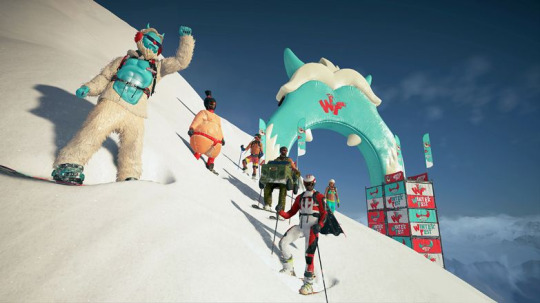
Winterfest's events were at least a change of pace with different kinds of activities to do, along with a dash of silliness. The Extreme pack is the most substantial as it adds new event types: the underwhelming base jump, the underutilised hybrid ski/speed-paragliding, and the unbridled excess of the rocket wings, easily the standout for both exciting flight tasks and expedited map coverage. The X-Games pack on the other hand was a flop, consisting mostly of repeated score runs of the same highly curated trick course.
Sadly one of the DLC packs is no longer available: the PyeongChang Winter Olympics had a tie-in, but the notorious Olympics licence has expired and you can no longer buy this expansion, even though all the hooks and prompts for it are still in the game. You can still travel to the region where there is lots to do outside of the Olympic events, but the vast majority of this area is set in Japan, with the sole South Korean sub-zone existing on the map but you are barred from entering it if the DLC is not owned. This felt like a let-down especially since Japanese culture already gets a lot of representation in video games worldwide, unlike Korea. There are events that retell folk stories, for example, and I think it was a missed opportunity personally to hear stories I didn't already know.
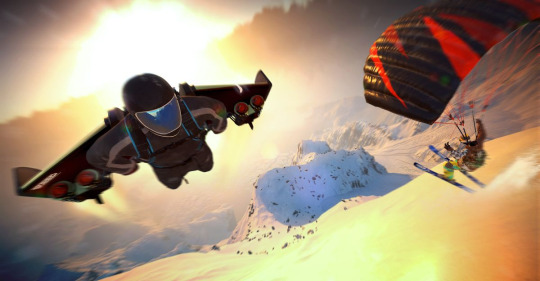
Still, exploring the Japan zone and the Alaska zone (which I had only partially cleared last time) was a lot of fun and each area has some of its own character despite being made up of the same white snow, black rocks, and blue ice; like how the grey trees have different shapes! The bleak beauty of these snowscapes captivated me again, although you have to be careful of the vertiginous upper half of the screen when things get *steep* (title drop).
So yes, Steep is still a nice time, despite the finicky menus and tricky controls. It's better to flow through the game, as hunting down events that you're missing or trying to navigate the progress bars and suggestions can get tedious. And honestly… it's impressive that it all exists in one huge contiguous open world (or three sub-worlds, I guess) but I will once again be a hater of this trend and say that the open world aspect isn't really necessary, and leads to some blandness and filler in the content and presentation. The best parts are the most hand-crafted lines and unique events, and the game will fail you for straying from intended paths during events anyway, so what's the point? Anyway rant over, snowboarding is cool eh?
1 note
·
View note
Text
[Review] Donut County (PS4)

"You play a hole"
I realised I had another indie game in my library inspired by Katamari, so it was a good time to knock it off the ol' backlog. Now while the mechanics take some inspiration, it's more of a story-driven puzzle game. The brainchild of Ben Esposito (part of the eclectic Arcane Kids collective), the game was initially created during one of the Idle Thumbs game jams based on the whimsical game idea posts of parody account Peter Molydeux. The simple idea of playing as a hole turned out to be a winner, and opened the door for a satisfying gameplay loop as well as a satirical story that finally took down capitalism for good. Oh, wait.
In a small town in rural America, a community of animal people, strange creatures, and one human find that the raccoons who have taken over the local doughnut shop are delivering not doughnuts but remotely-controlled holes in the ground in order to gather the thing most beloved to them: rubbish. You play as one of the employees, the raccoon BK, who selfishly destroys the town in order to acquire a quadcopter. His human friend Mira is more the protagonist of the story, and she has to convince BK to rebel against his corporate overlords.

This all plays out in simple, amusing cutscenes as the characters linger underground, with flashbacks showing how they each ended up falling down there. These funny little folks talk in text/chat speak, so everything has a casual vibe that keeps things light. Sometimes you even advance the story by literally texting other characters, which can make certain levels tedious to replay as you mash through these exchanges (you only need to do this for achievements though, unless you just want to, like, have fun with a particular level).
The story is more than just a framing device for the action, with some clear themes and social commentary to it, which I admire, but it certainly has fun along the way with goofy characters and running jokes. The gameplay too manages to be inherently comedic despite being kind of horrifying, and this too is on purpose!

Levels play out as bite-sized puzzles where you have to absorb objects in the right order so your hole grows and can absorb more objects. As you proceed new gimmicks are introduced, with different ways that the hole reacts to water, pulling on tethered objects, and even launching objects back out of the hole to interact with things. In its three hour runtime Donut County does enough to keep things interesting with the hole mechanics, even without the story pulling you along or wanting to read the funny raccoon-oriented descriptions of objects you've sucked in.
I think the evidence that Esposito had a great, original idea here is that cheap clones sprung up after (and in one case, slightly before) this game released. These shallow imitators ape the gameplay, but without the themes, writing, art design, soundtrack, puzzles, and wit that make Donut County one of a kind. It's a great example of contrasting expressions of remix culture; Donut County is collaborative, iterative, creative, and well worth checking out.
4 notes
·
View notes
Text
[Review] NuPa: Numeric Paint Puzzle (PSX)
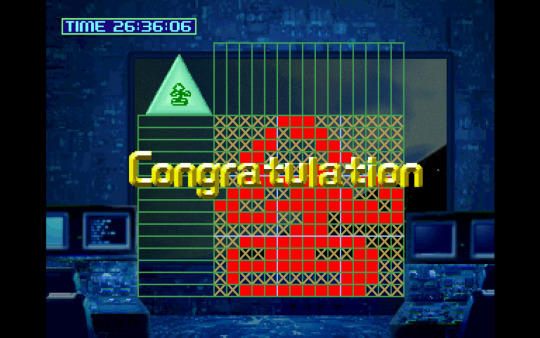
One of the lost Picross games.
While languishing in my sick bed for two weeks, I filled some time with this 1995 nonogram puzzler (also serving as an emulation test on my Steam Deck). Created by Jupiter aka the Picross people, much like Pictlogica Final Fantasy this couldn't use the Picross name which is owned by Nintendo, who weren't involved as Tomy published this for Sony’s PlayStation. It still plays almost exactly like Mario's Super Picross, its direct predecessor, but there are some touches only the disc-based format could provide.
For starters, there is a sci-fi framing device to NuPa, where two space folks in mech pods explore an alien planet, solving puzzles to unlock artfeacts that reveal information about… Earth culture!? (In a shock twist, one of them is transformed into a puzzle at the end!) There are a handful of voiced CG cutscenes to support this, unfortunately not subtitled. It informs the styling of the menus and the single puzzle backdrop, making for a nice cohesive theme. Solving a puzzle gives you a 3D polygonal hologram representing the picture you created, which is pretty cool and unique for these games and another consequence of the PSX's abilities and storage space.
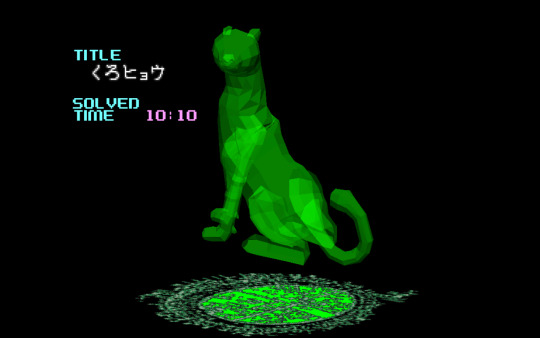
The puzzle mechanics are not too advanced, coming as it does so early in Jupiter's development of the Picross series. There’s no screen wrap, hint numbers don’t auto-mark until you complete a row or column (although you can manually mark them), and you’re stuck with the Picross “Normal” mode where time ticks down and your mistakes are penalised and corrected straight away. There’s no hints and the difficulty gets quite high late on; I’m certain that some puzzles require extrapolation to solve, with no gameplay function to support it!
NuPa has a few unique features related to the difficulty. Every puzzle is given a difficulty rating out of 200 on the selection screen (a fun arrangement of green triangles). Mistakes don’t just incur a time penalty, but the triangle cracks with each one and breaks on the fourth, an instant fail. This adds some character related to the theming, and with the huge size of some of these puzzles the countdown timer seems harsh and maybe not even necessary with this penalty mechanic.
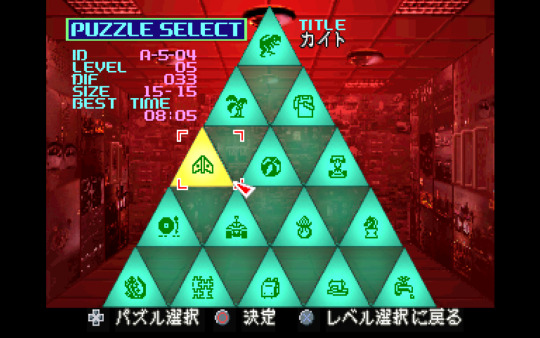
The puzzle pictures are pretty varied but I noticed that like Picross 2 on the Game Boy, many of them are specific to Japanese culture which may have been a barrier to localisation (among other reasons). Still, it’s perfectly playable without knowing the language. My biggest nitpick is that the selection cursor is a little overbearing in how it highlights the clues, but it’s not as bad Iraroji VOW.
With 300 puzzles (the same as Mario’s Super Picross) there’s plenty to keep you busy, although this isn’t the most accessible nonogram game due to the PSX-long loading and saving times (my emulator’s turbo button came in very handy). It does have a two-player mode which is a silly novelty, but the theme and how it’s served throughout the game are what really make this stand out, especially among the later more sterile Picross entries. It’s still up to Jupiter’s high standard for fun puzzle gameplay, so don’t miss it!
12 notes
·
View notes
Text
[Review] Mini Golf Arena (PC)
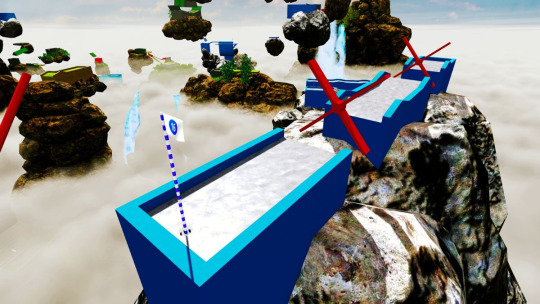
Steam dumpster diving… hidden gem, or just rubbish?
My brother and I have played more than a few cheap mini golf games in our time, but few more cheap-feeling than this. The stock assets and janky play control are hallmarks of the genre, but all the same it’s always a good time hanging with my bro and yelling at the game.
As with other games of this type, you can customise your ball colour, look, and trail (mine became a buckminsterfullerene that trailed clipart cats behind it!), and all the unlockable options are exorbitantly expensive in the in-game currency, earned by playing. Gameplay settings were a bit lacking, merely collision and jump toggles with no option to change the stroke limit from the default 12; it’s never a good feeling to be cut short during your attempt, even when the holes are as dodgy as these.
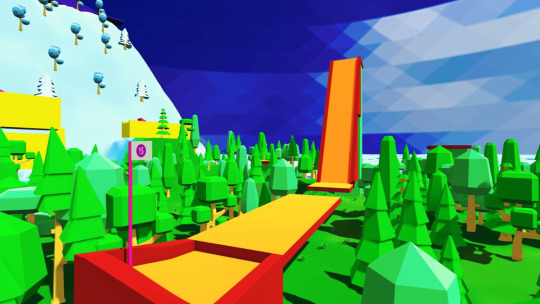
And they are dodgy, with difficulty stemming from mandatory ramp jumps or holes placed in the course to send you out of bounds (with a stroke penalty!), or our favourite, the poorly-lined up pyramid under the goal. The lacklustre course design combos with the off-feeling physics and gimmicks that just don't work sometimes for a full course of frustration, with a garnish of online issues that for one round cut Cam off every time I sunk my ball before him. The mouse-controlled putt meter is my preferred option, but here it's the only option so get used to it.
There are seven 18-hole courses to play, with some decent variety in the aesthetics, from Mars to a neon sci-fi-scape to a bright, flat-shaded, low-poly fantasy zone of some kind. The look tends towards oversaturated and bloomy, the eye-bleed peaking on the hellish "Eclipse" course. There's also support for user-made maps, although we opted not to explore them; besides, the feature doesn't seem to have the breadth of engagement as the bigger names like Golf With Your Friends or Golf It.

Technically this game is in early access, but the last update was over three years ago and the developer's website is down, so I reckon it's unlikely to make it to "released". Still, as clumsy and slipshod as this is I still appreciate that people out there are getting in and having a go at making games. The rough edges give it a bit of character, and there was a feature that genuinely and consistently tickled us: the announcements of your scores at the end of each hole, where an Eastern European gentleman yells various versions of "PARRR!" or "double bogey..." at you. This is what video games are all about.
2 notes
·
View notes
Note
Heyo! I've been trying to gather info on the Ecco LCD games in hopes they might be able to be preserved in Itizso's RetroFab project, and I struck gold when I found your review on them! Would you still happen to have the manuals for both those games? If you do, could you please consider scanning them and uploading the files to the internet somehow? They're currently not preserved anywhere on the web at the moment. Let me know! Thank you!
Hi! It would be amazing for these to be preserved in RetroFab, so I'm happy to do anything I can to help! Sadly I got my copy of the second Ecco LCD game loose, so I don't have the manual for that one. But I do have the manual for the first one. I even already have a scan of this manual in my files, link here. Let me know if the quality is ok, otherwise I can try to scan it in better.
6 notes
·
View notes
Text
[Review] Aperture Desk Job (PC)
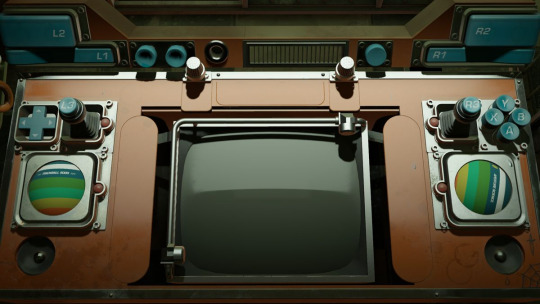
Talking and fun, testing and fun.
I realised after three weeks of owning a Steam Deck that I should try this free tech demo that Valve made specifically to demonstrate the capabilities of the Steam Deck. So, I did. It's a half-hour little adventure set in the Portal universe, specifically the old days of Aperture when Cave Johnson was running the place.
The whole thing plays out with a fixed perspective as you sit at your "desk" which happens to have all the same buttons and features as a Steam Deck. Grady, a robot on a stick, talks you through the process with a lot of shenanigans along the way. You start by testing toilets, but a mishap results in the invention of the toilet-based gun turret which leads to some brief shooting sections and things escalate from there until a fateful meeting with Cave himself (in the form of a giant head) caps off the experience.
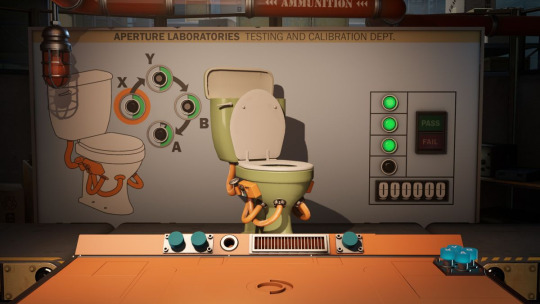
Without much in the way of challenging gameplay, it's a very directed experience where the writing and gags take centre stage, making it a comedy game of sorts. Unsurprisingly it's very much in the Portal 2 school of humour, and there's plenty of ways for the characters to say similar instructions if you dawdle. The silly turns and asides are amusing, including a civilisation of mantises living in the walls, wanton destruction of Aperture assets leading to imprisonment, and a rivalry with the homewares department. JK Simmons is excellent as always in the role of the kooky CEO, while breakout comedian Nate Bargatze holds his own as Grady, your constant companion.
I suppose I should say something about the Steam Deck itself. The construction is high quality, and the screen is large and bright. The touch panels work quite well when required to simulate a mouse, and otherwise the touch screen serves the purpose. The button layout suits my hand size well at least, although L1/R1 are perhaps the hardest to reach aside from the bonus 3 and 4 buttons which are just nice for when a game requires a remapped keyboard press every now and then (the options for remapping are clear and useful). Although it's large, it's relatively light and comfortable to hold, and the interface is nice and snappy. My main problems with the software have been when I have needed to venture into desktop mode and then got confused, or the system got locked up when switching over. But I appreciate that there's lots you can do outside of the main Steam mode, like installing Linux games or emulators; this has quickly become my go-to device for retro games!
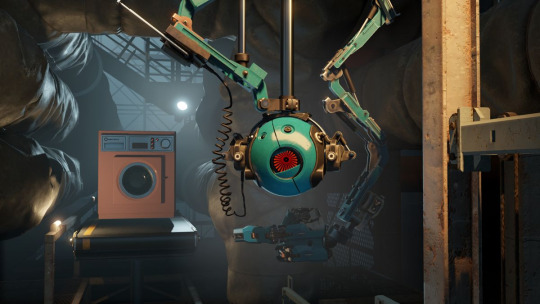
Anyway, I don't know if this is even playable without a Steam Deck, but it's a fun little slice of the Portal universe that's free to download. If it is locked to the hardware that would be a shame, but it certainly wouldn't be alone with the multiple bits of Portal and Half-Life content that are locked to VR headsets or motion controllers. Valve and their experiments eh?
6 notes
·
View notes
Text
[Review] Year Walk (Wii U)
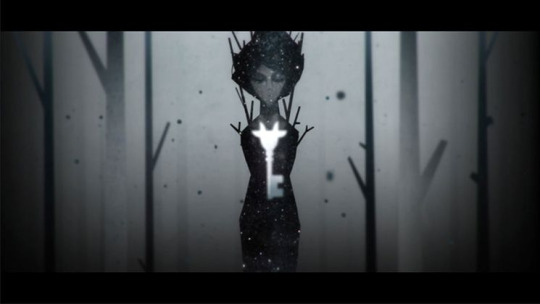
A dark and compelling Scandi fairy tale… now with gyro controls!
After playing Lorelei and the Laser Eyes, I was curious about Simogo's other moody puzzle adventures, especially this one which got an enhanced port to the Wii U. Now of course you can't buy Wii U games anymore, but there are more custom ways, and of course I supported the developer by buying a copy on Steam as well!
Year Walk leans into the developers' Swedish origins by portraying the old folk ritual of årsgång, where by deprivation and quest one might catch a glimpse of the future. This plays out as a short horror-puzzle adventure where you navigate a small forest, gathering clues and encountering dangerous creatures from Scandinavian folklore such as the Brook Horse and Church Grim.
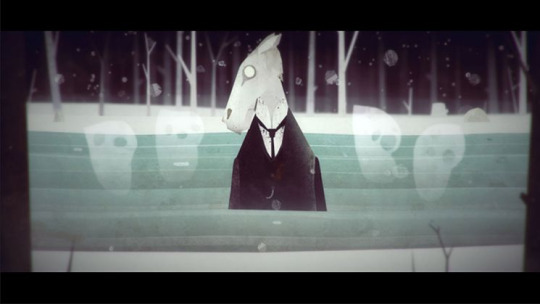
Your surroundings are rendered like a bleak but beautiful watercolour pop-up book. Each screen is a simple 2D line with exits above and below, and occasional things to interact with. Year Walk keeps things fairly simple with the controls, but requires some note-taking to match up patterns and symbols. When you find one of the forest's monsters, things go beyond creepy fairy tale into the territory of jumpscares and slightly disturbing imagery, so be warned.
The ending is especially grim, but a post-credits scene hints at a deeper mystery that reveals a new layer to the story, explored via journal entries from a modern scholar of these cultural practices. I found it interesting, especially with respect to Lorelei which expands on similar concepts.

As a bite-sized but evocative puzzle game with some nice cultural ties it's a nice little package, but I found it rewarding to learn about the game's development history as well. Originally teased and hinted as almost an ARG, it arrived on iOS alongside a companion app with more background on the mythology involved, which does also have some gameplay relevance. A year later it received a computer port, which updates some things, integrates the encyclopedia, and adds a handy map. I found it worked well on Steam Deck with a combination of button and touchscreen controls. The Steam release also uniquely has achievements, some of which act as extra bonus puzzles.
The Wii U version came as a result of Nintendo courting indies in that era, with the porting help of Dakko Dakko. This goes all in on Gamepad features, with lots of gyro and rotation for basic actions, which I found strained my wrists a bit. There's an added interaction or two and certain notes and documents are now presented in Swedish with a translation for enhanced verisimilitude, but the use of the second screen is what makes this the definitive way to play for me, as it enables easy reference of the map, journal, etc. while keeping them separate from the context of the action in the forest. It also adds an in-built note-taking function, and an alternate more involved puzzle to unlock the second ending which even makes use of the normally dry Wii U digital manual!

I don't mind a bit of creepiness but outright horror and frights don't agree with me. But apart from these popping up infrequently, I found this very compelling, even clearing it multiple times for those Steam achievements. Unlike with Lorelei, there's no randomisation in the puzzles so each playthrough is more or less identical, but the game is most effective as a one and done in a single sitting anyway. The art design with its painted style and stop-motion-esque characters is strong and makes for a thick atmosphere; I also saw shades of Sayonara Wild Hearts in the more surreal moments… by the way, you can get that game, this one, and Lorelei in a bundle on Steam you know! They're all very good!
4 notes
·
View notes
Text
[Review] The Wonderful End of the World (PC)

"We have Katamari at home."
While playing the latest two Katamari games, I remembered playing the demo for this many years ago on my family computer, when Steam was new to us and free gaming experiences were precious. Dejobaan Games is a small American studio led by Ichiro Lambe who later would join Valve himself, but this is one of their earliest games, and it doesn't really try to hide that it's a Katamari clone. But that's ok!
The game itself has no explanation of the premise (or a credits sequence for that matter), but the store description lays out that the end of the world is imminent, and your task as a kind of magical puppet is to absorb objects in order to save them before disaster strikes. We can also gather from the title and menu screens and their vocal theme song that there's some girl with a knowing smirk who is controlling the puppet. That's about it. To be fair you don't need much of an excuse, and honestly I was sick of the King of All Cosmos's long rambling monologues anyway…

As this homunculus, you run around small levels picking up things and growing larger. It's all very familiar, except without the unique and tricky control scheme that Katamari is known for. It still works with a simple movement method though, and the core gameplay remains inherently satisfying. The 12 levels are simpler and shorter than most Katamari stages, but they have an interesting variety to them. For example, in addition to more standard locations like a library, a neighbourhood, and a mall, you get more abstract stages: a mashup of classic arcade games, an assortment of word blocks, a garden made of sweets, or one where the objects to gather are in a 2D clip art style. There's also two secret levels that uniquely give you the ability to jump [space bar]; both are made of stacked cube blocks but one of them themes said blocks after Portal's companion cube, complete with a cover of Still Alive!

The objects that you gather are more detailed than Katamari's intentionally low-poly style, but with a sort of amateurish, homebrew feel to the modelling. I found it difficult at times to judge whether I'd be big enough to absorb them or not, as their relative volumes aren't as clearly communicated as in TWEotW's inspiration. You're also scored on number of objects collected rather than your total size, and I couldn't tell if there was a weighting factor to my growth or if that was also based on a simple quantity. Progression is gated by getting A ranks in levels, which require you to reach a hidden size/object goal within the short time limit, but you can replay levels without a time restriction.
Judged strictly against Katamari games, this feels like a low-rent knockoff. But in its context it was a part of the exciting 2000s indie boom, a new studio finding its feet with a proven formula, a cheaper computer-based homage to a console-exclusive franchise, and for me a fun few hours on my Steam Deck while sick in bed. For a game made by six people it's a decent Katamari clone and I'm glad it exists. The demo is still available so try it out why not!
2 notes
·
View notes